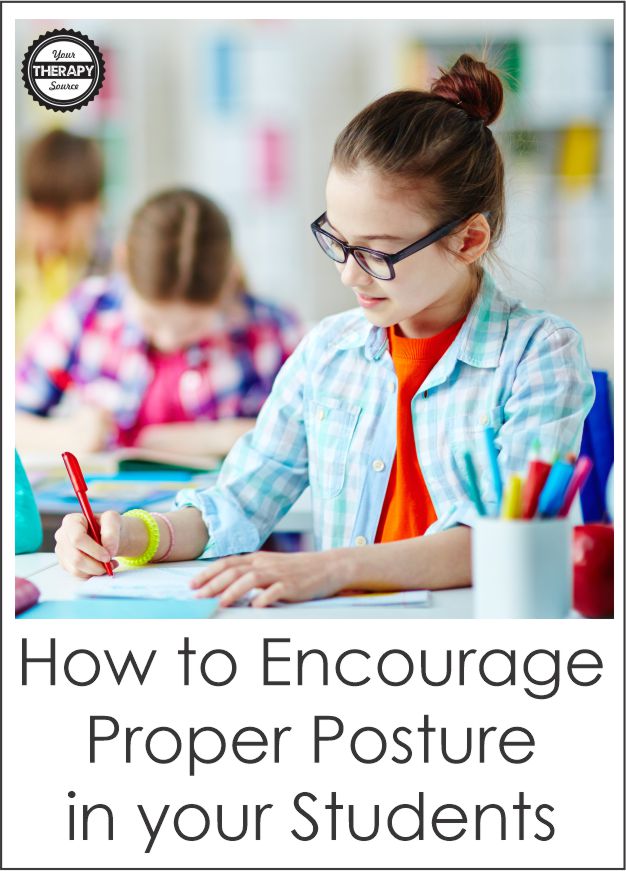Writing Posture – Free Printable
Writing posture in school may be more important than you realize. If you look around a classroom, often times you will see students slumped over in their seats, wiggling, or slouching. It is hard work to maintain good posture especially when talking about proper handwriting posture.
Students need to learn how to maintain proper writing posture to prevent long term bad habits. You can download a free poster to get started to help demonstrate correct sitting posture while writing at the bottom of the post.

What Does Bad Posture Look Like?
Bad posture doesn’t just mean slouching in a chair. If you work in a school you witness it daily. It can also present as:
- constant wiggling
- resting your head in your hands
- head on the desk or very close to assignments
- falling out of the classroom chair
- rounded shoulders and head looking down
- muscle weakness if students can not maintain upright sitting
- sitting on the edge of the chair
- tipping the chair back
- low back pain
- sitting on your feet in your chair
And the list goes on and on!
How Can Good Posture Effect Student Performance?

Of course, bad posture can result in long term problems with neck and spine health. But what about academic skills or emotional regulation?
Did you know that research suggests that adopting an upright posture results in maintaining a positive psychological state and improving test performance of children? Wow, proper posture can even influence your mood, calculations and how your students listen (Inagaki et al, 2018).
Other research suggests that the more a student is wiggling their bottoms, there is an increase in the odds of erasing and overwriting letters in dictation tasks (Pade et al, 2018).
Body posture can influence handwriting skills. Parush and other researchers found that children with poor handwriting had inferior pencil, paper and body positioning, stabilization of paper and consistency of pressure, compared to children with good handwriting (Parush et al, 1998).
Poor body positioning of school aged children is often influenced by classroom furniture. One study suggested that the fit of furniture relative to the child’s size may have a significant impact on a young, typical child’s object manipulation skills especially complex hand skills, such as those involving in-hand manipulation with stabilization ( Smith-Zuzovsky & Exner, 2004).
What is Proper Writing Posture?
When students and adults sit down to write it is important to have proper desk and chairs for comfortable seating.
Correct sitting posture while writing should include:
- the feet should have a stable base of support.
- hips, knees, and ankles should be bent at 90 degrees.
- desk should be 1-2” higher than bent elbows.
- on the desk, the paper should be angled. Angle it so that the right side of the paper is slightly higher for right handed students.
- stabilize the paper with your non-dominant hand.
What Can You Do to Improve Handwriting Posture?

Here are some suggestions to help improve your student’s (and your own) writing posture:
- provide a visual cue of what proper writing posture looks like by downloading and printing the freebie below.
- check and double check desk and chair height.
- educate children on the importance of proper posture and how it can help their overall health, mood, and academic success.
- complete postural exercises to help maintain strong neck and back muscles.
- try using a slant board at an angle to improve posture while writing.
- take frequent breaks from seated work to stretch.
- incorporate movement breaks with physical activity throughout the day.
Resources to Help
If you want to get started right away, the Handwriting Station includes materials you will need to create a workspace to encourage proper handwriting posture. This digital download packet will help get your handwriting station up and running in no time.

Download your FREE Writing Posture Poster Here
References:
Inagaki, K., Shimizu, T., & Sakairi, Y. (2018). Effects of posture regulation on mood states, heart rate and test performance in children. Educational Psychology, 38(9), 1129-1146.
Pade, M., Liberman, L., Sopher, R. S., & Ratzon, N. Z. (2018). Pressure distributions on the chair seat and backrest correlate with handwriting outcomes of school children. Work, 61(4), 639-646.P
Parush, S., Levanon-Erez, N., & Weintraub, N. (1998). Ergonomic factors influencing handwriting performance. Work, 11(3), 295-305.
Smith-Zuzovsky, N., & Exner, C. E. (2004). The effect of seated positioning quality on typical 6-and 7-year-old children’s object manipulation skills. American Journal of Occupational Therapy, 58(4), 380-388.



